
Innovation outposts provide companies with external hubs to explore emerging technologies and market trends through proximity to startups and industry ecosystems. Internal incubators focus on developing in-house ideas by fostering collaboration among employees and allocating resources to nurture early-stage projects. Discover how these approaches can accelerate your organization's innovation strategy.
Why it is important
Understanding the difference between an innovation outpost and an internal incubator is crucial for aligning corporate innovation strategies with business goals. Innovation outposts focus on scouting emerging technologies and trends externally, while internal incubators develop and test new ideas within the organization. Properly distinguishing these models helps allocate resources efficiently and accelerates meaningful innovation outcomes. This knowledge supports optimized decision-making in managing innovation ecosystems effectively.
Comparison Table
| Feature | Innovation Outpost | Internal Incubator |
|---|---|---|
| Location | External, often in tech hubs | Within company premises |
| Focus | Scouting emerging technologies and startups | Building and scaling internal projects |
| Speed | Fast external insights and validation | Slower, structured development process |
| Resources | Limited, relies on partnerships | Dedicated company funding and teams |
| Risk | Lower direct investment risk | Higher risk due to own resource allocation |
| Innovation Type | Disruptive and external-driven | Incremental and internal-driven |
| Strategic Role | Early detection of market trends | Development and commercialization of ideas |
| Examples | Google's innovation outposts in Silicon Valley | Amazon's internal product incubators |
Which is better?
An innovation outpost focuses on scouting emerging technologies and market trends by establishing a presence in innovation hubs, providing early access to external ideas and partnerships. An internal incubator leverages company resources to develop and validate new products or business models within a controlled environment, accelerating innovation cycles and aligning closely with corporate strategy. Selecting between the two depends on organizational goals: innovation outposts excel in external opportunity identification, while internal incubators drive focused, in-house project development.
Connection
Innovation outposts and internal incubators are connected through their shared goal of fostering breakthrough ideas by integrating external market insights with internal development processes. Innovation outposts scout emerging technologies and trends in dynamic ecosystems, providing startups and novel concepts that internal incubators can rapidly prototype and scale within the organization. This symbiotic relationship accelerates corporate innovation cycles, ensuring competitive advantage and sustained growth in volatile markets.
Key Terms
Resource allocation
Internal incubators centralize resource allocation within the organization, allowing dedicated teams to develop and scale innovative projects using company assets and expertise. Innovation outposts allocate resources by establishing external units in strategic locations to tap into local talent, market intelligence, and emerging technologies. Explore deeper insights to optimize resource allocation strategies between internal incubators and innovation outposts.
Strategic alignment
Internal incubators foster strategic alignment by nurturing innovative projects within the core organizational framework, ensuring initiatives closely reflect company goals and culture. Innovation outposts, positioned externally, gather emerging trends and technologies to complement the main business strategy without direct operational integration. Explore in-depth comparisons on how strategic alignment impacts innovation success in diverse organizational models.
Talent sourcing
Internal incubators leverage existing employee expertise and foster a culture of intrapreneurship to source high-potential talent within the organization, nurturing innovation from within. Innovation outposts operate in strategic external locations, tapping into local talent pools, startups, and academic institutions to access diverse skills and emerging technologies. Explore how each model impacts talent acquisition strategies and drives sustainable innovation growth.
Source and External Links
Fix the Innovator's Dilemma with an Incubator - Brightidea - An internal incubator is a safe space within a company insulated from usual pressures, designed to foster and test new ideas in research, development, or production while protecting the core business from innovation risks.
Corporate Startup Incubators: The Expert Guide - Bundl - Internal incubators act as internal startup factories that transform employee ideas into disruptive innovations, promoting creativity and entrepreneurial culture to drive business growth and digital transformation.
The next generation of corporate incubators | Arthur D. Little - Managed by in-house corporate teams, internal incubators maintain company control over innovation but require sufficient separation from daily pressures to avoid constraints that hinder breakthrough innovation.
 dowidth.com
dowidth.com